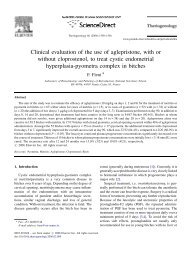Treatment of canine atopic dermatitis: 2010 clinical practice ...
Treatment of canine atopic dermatitis: 2010 clinical practice ...
Treatment of canine atopic dermatitis: 2010 clinical practice ...
Create successful ePaper yourself
Turn your PDF publications into a flip-book with our unique Google optimized e-Paper software.
Olivry et al.<br />
Box 2. Excerpts from the International Task Force on Canine Atopic<br />
Dermatitis position on the relationship between food allergy and<br />
<strong>atopic</strong> <strong>dermatitis</strong> in dogs<br />
Food allergy (also known as adverse food reaction) isanaetiological<br />
diagnosis. In dogs, cutaneous <strong>clinical</strong> manifestations <strong>of</strong><br />
food allergies have been reported as focal, multifocal or generalized<br />
pruritus, otitis, seborrhoea, superficial pyoderma and also, in<br />
some dogs, as <strong>atopic</strong> <strong>dermatitis</strong>. These cutaneous manifestations<br />
can <strong>of</strong>ten be accompanied with digestive signs.<br />
Atopic <strong>dermatitis</strong>, in dogs and humans, is a <strong>clinical</strong> diagnosis. It<br />
can be exacerbated by an exposure to allergens, which can be <strong>of</strong><br />
environmental (e.g. mites, pollens), microbial and also, in some<br />
dogs, dietary origin.<br />
Position statement: the International Task Force on Canine<br />
Atopic Dermatitis supports the concept that cutaneous adverse<br />
food reactions (food allergies) might manifest as <strong>atopic</strong> <strong>dermatitis</strong><br />
in some <strong>canine</strong> patients, or, in other words, that food components<br />
might trigger flares <strong>of</strong> <strong>atopic</strong> <strong>dermatitis</strong> in dogs hypersensitive<br />
to such allergens.<br />
Implications for <strong>clinical</strong> <strong>practice</strong>: Food allergies can manifest<br />
<strong>clinical</strong>ly, in some dogs, as <strong>atopic</strong> <strong>dermatitis</strong>, but not every dog<br />
with food allergy will manifest it as <strong>atopic</strong> <strong>dermatitis</strong>. Atopic <strong>dermatitis</strong><br />
can be exacerbated by food allergens, but not every dog<br />
with <strong>atopic</strong> <strong>dermatitis</strong> will have dietary-induced flares. Every dog<br />
diagnosed with nonseasonal (i.e. perennial) <strong>atopic</strong> <strong>dermatitis</strong><br />
should undergo one or more dietary restriction-provocation challenges<br />
(i.e. ‘elimination diets’) to determine, and then eliminate,<br />
any dietary allergens that might cause flares <strong>of</strong> the disease.<br />
Olivry T, DeBoer DJ, Bensignor E, Prélaud P for the International<br />
Task Force on Canine Atopic Dermatitis. Food for thought:<br />
pondering the relationship between <strong>canine</strong> <strong>atopic</strong> <strong>dermatitis</strong> and<br />
cutaneous adverse food reactions. Veterinary Dermatology 2007;<br />
18: 390–1.<br />
listed in a particular order, but this does not mean that all<br />
recommendations are advised or needed in that specific<br />
sequence. First and foremost, practitioners shall examine<br />
the validity <strong>of</strong> these recommendations in the context <strong>of</strong><br />
their patient, the pet owners and the availability and<br />
cost <strong>of</strong> the products in their respective countries. Again,<br />
veterinarians must remember that it is <strong>of</strong>ten necessary<br />
to combine several interventions in order to achieve a<br />
satisfactory outcome.<br />
<strong>Treatment</strong> <strong>of</strong> acute flares <strong>of</strong> AD<br />
Case Scenario 1. A 3 year old male castrated English bull<br />
terrier has suffered from intermittent pruritic skin lesions<br />
diagnosed as AD for the last 2 years. It is now the peak <strong>of</strong><br />
the season for grass pollens to which he is hypersensitive;<br />
<strong>clinical</strong> signs have begun to reappear.<br />
Case scenario 1a (mild acute flares). The dog presents<br />
with erythematous and oedematous patches and excoriations<br />
<strong>of</strong> the axillae (Figure 1); he occasionally scratches<br />
his face and licks his feet.<br />
Case scenario 1b (moderate to severe acute flares).<br />
The dog is affected with multifocal patches <strong>of</strong> oedema,<br />
erythema, papules and excoriations on the axillae, groin<br />
and medial thighs (Figure 2). He scratches nearly nonstop<br />
all over the body.<br />
Figure 1. Localized acute flare <strong>of</strong> <strong>canine</strong> <strong>atopic</strong> <strong>dermatitis</strong>. This dog<br />
exhibits patches <strong>of</strong> erythema and oedema with excorations on both<br />
axillae (example <strong>of</strong> case scenario 1a).<br />
Identification and avoidance <strong>of</strong> flare factors<br />
Identification and removal <strong>of</strong> allergenic causes <strong>of</strong> flares.<br />
strength <strong>of</strong> recommendation SOR D (case scenarios 1a<br />
and 1b)<br />
Rationale for such recommendation. When an exacerbation<br />
<strong>of</strong> signs occurs in a dog that previously had a<br />
disease in complete or near complete remission,<br />
veterinarians must look for, and eliminate if at all feasible,<br />
the cause <strong>of</strong> such flares. Currently recognized<br />
sources <strong>of</strong> flares <strong>of</strong> <strong>canine</strong> AD include fleas, food and<br />
environmental (e.g. house dust mites, pollens) allergens.<br />
In case <strong>of</strong> acute AD exacerbation, especially in<br />
areas where flea infestation is endemic, practitioners<br />
must first verify if fleas could have contributed to the<br />
current worsening <strong>of</strong> signs. Similarly, owners should be<br />
queried about the ingestion <strong>of</strong> dietary items to which<br />
the dog is known to be hypersensitive. Finally, consultation<br />
<strong>of</strong> online pollen counts could help document<br />
whether <strong>of</strong>fending pollens are currently airborne in the<br />
local geographic area. Readers are referred to sections<br />
below for further details on flea control and dietary<br />
restriction measures.<br />
Evaluation <strong>of</strong> use <strong>of</strong> antimicrobial therapy: SOR D (case<br />
scenarios 1a and 1b)<br />
Rationale for such recommendation. Skin and ear infections<br />
are common reasons why lesions and pruritus<br />
acutely worsen in dogs with AD. If bacterial or yeast<br />
infections are identified with some combination <strong>of</strong><br />
<strong>clinical</strong> signs, cytology and ⁄ or culture, antimicrobial<br />
therapy is indicated, normally using a combination <strong>of</strong><br />
topical with or without oral medications (COE IV). For<br />
skin infections, shampoos or solutions containing antibacterial<br />
(e.g. chlorhexidine, ethyl lactate, triclosan)<br />
and ⁄ or antifungal (e.g. miconazole, ketoconazole) medications<br />
are beneficial. Because <strong>of</strong> their drying and irritating<br />
effects, benzoyl peroxide-containing formulations<br />
are not recommended in dogs with AD without a<br />
subsequent topical moisturizer (COE IV). If lesions <strong>of</strong><br />
bacterial or fungal skin infections are localized, ointments,<br />
creams, gels or wipes containing antiseptics<br />
(e.g. chlorhexidine), antibiotics (e.g. mupirocin, fusidic<br />
4 ª <strong>2010</strong> The Authors. Journal compilation ª <strong>2010</strong> ESVD and ACVD, Veterinary Dermatology








